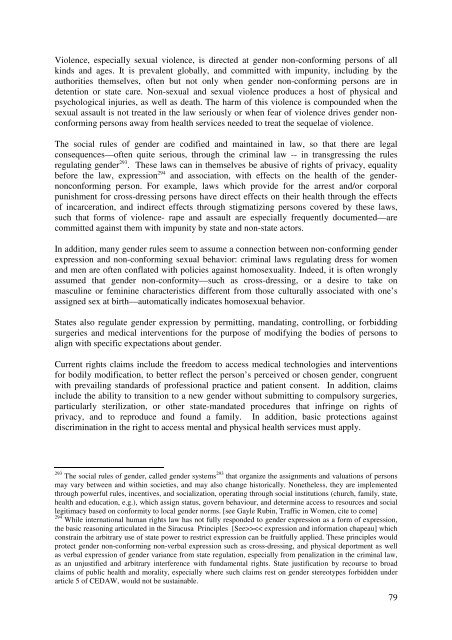SEXUAL HEALTH AND HUMAN RIGHTS A legal and ... - The ICHRP
SEXUAL HEALTH AND HUMAN RIGHTS A legal and ... - The ICHRP
SEXUAL HEALTH AND HUMAN RIGHTS A legal and ... - The ICHRP
You also want an ePaper? Increase the reach of your titles
YUMPU automatically turns print PDFs into web optimized ePapers that Google loves.
Violence, especially sexual violence, is directed at gender non-conforming persons of all<br />
kinds <strong>and</strong> ages. It is prevalent globally, <strong>and</strong> committed with impunity, including by the<br />
authorities themselves, often but not only when gender non-conforming persons are in<br />
detention or state care. Non-sexual <strong>and</strong> sexual violence produces a host of physical <strong>and</strong><br />
psychological injuries, as well as death. <strong>The</strong> harm of this violence is compounded when the<br />
sexual assault is not treated in the law seriously or when fear of violence drives gender nonconforming<br />
persons away from health services needed to treat the sequelae of violence.<br />
<strong>The</strong> social rules of gender are codified <strong>and</strong> maintained in law, so that there are <strong>legal</strong><br />
consequences—often quite serious, through the criminal law -- in transgressing the rules<br />
regulating gender 293 . <strong>The</strong>se laws can in themselves be abusive of rights of privacy, equality<br />
before the law, expression 294 <strong>and</strong> association, with effects on the health of the gendernonconforming<br />
person. For example, laws which provide for the arrest <strong>and</strong>/or corporal<br />
punishment for cross-dressing persons have direct effects on their health through the effects<br />
of incarceration, <strong>and</strong> indirect effects through stigmatizing persons covered by these laws,<br />
such that forms of violence- rape <strong>and</strong> assault are especially frequently documented—are<br />
committed against them with impunity by state <strong>and</strong> non-state actors.<br />
In addition, many gender rules seem to assume a connection between non-conforming gender<br />
expression <strong>and</strong> non-conforming sexual behavior: criminal laws regulating dress for women<br />
<strong>and</strong> men are often conflated with policies against homosexuality. Indeed, it is often wrongly<br />
assumed that gender non-conformity—such as cross-dressing, or a desire to take on<br />
masculine or feminine characteristics different from those culturally associated with one’s<br />
assigned sex at birth—automatically indicates homosexual behavior.<br />
States also regulate gender expression by permitting, m<strong>and</strong>ating, controlling, or forbidding<br />
surgeries <strong>and</strong> medical interventions for the purpose of modifying the bodies of persons to<br />
align with specific expectations about gender.<br />
Current rights claims include the freedom to access medical technologies <strong>and</strong> interventions<br />
for bodily modification, to better reflect the person’s perceived or chosen gender, congruent<br />
with prevailing st<strong>and</strong>ards of professional practice <strong>and</strong> patient consent. In addition, claims<br />
include the ability to transition to a new gender without submitting to compulsory surgeries,<br />
particularly sterilization, or other state-m<strong>and</strong>ated procedures that infringe on rights of<br />
privacy, <strong>and</strong> to reproduce <strong>and</strong> found a family. In addition, basic protections against<br />
discrimination in the right to access mental <strong>and</strong> physical health services must apply.<br />
293 <strong>The</strong> social rules of gender, called gender systems 293 that organize the assignments <strong>and</strong> valuations of persons<br />
may vary between <strong>and</strong> within societies, <strong>and</strong> may also change historically. Nonetheless, they are implemented<br />
through powerful rules, incentives, <strong>and</strong> socialization, operating through social institutions (church, family, state,<br />
health <strong>and</strong> education, e.g.), which assign status, govern behaviour, <strong>and</strong> determine access to resources <strong>and</strong> social<br />
legitimacy based on conformity to local gender norms. [see Gayle Rubin, Traffic in Women, cite to come]<br />
294 While international human rights law has not fully responded to gender expression as a form of expression,<br />
the basic reasoning articulated in the Siracusa Principles [See>>

















